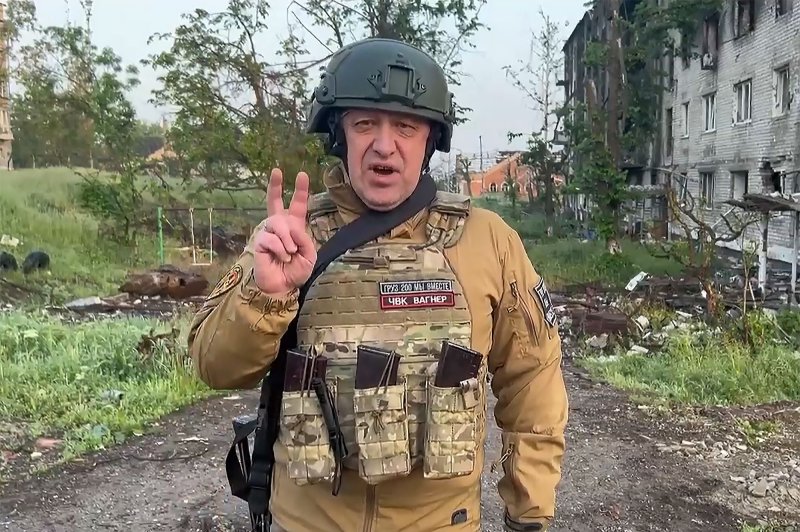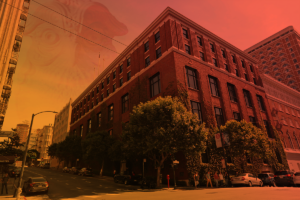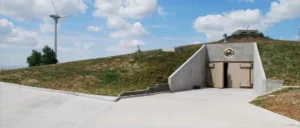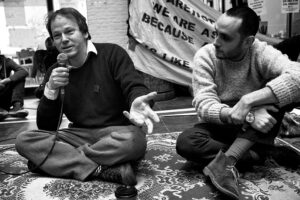Putin’s Little Monster
Yevgeny Prigozhin's mutiny was a product of the Kremlin's doomed attempt to balance regime-building and state-building. Photo: Press Service of Yevgeny Prigozhin
Photo: Press Service of Yevgeny Prigozhin
Founded in 2014 as a private military company owned by the Russian businessman and Putin confidante Yevgeny Prigozhin, the Wagner Group first saw action in Donbas, where it helped separatist forces against the Ukrainian army. Subsequently, it had been deployed in Syria, Libya, and a number of other African countries, usually offering Russia a plausible deniability for its military interventions and flexibility that the army could not provide. Wagner’s peak of fame, however, came in the aftermath of Russia’s 2022 invasion of Ukraine. Having grown since then thanks to generous recruitment packages (officially valued at 850 bln roubles or $10 bln though unclear for what period) and promises of freedom to Russian inmates who joined, it has been touted as one of the most effective combat units on the Russian side thanks largely to its commanders’s disregard for casualties. More recently, Prigozhin and his media empire had been criticizing the conduct of the war from the right and had entered into a growing conflict with the leadership of the Russian army, which culminated on June 24th 2023 into Wagner’s “March on Moscow,” or “Prigozhin’s putsch.” Wagner troops had gotten within 200 km south of Moscow, before Prigozhin called off his coup, leaving most observers scrambling to explain the events of that day. LeftEast is delighted to present Ilya Matveev’s politico-economic analysis of the Wagner phenomenon, published originally in Russian on the Важные истории platform.
In his article “Russia at the Turn of the Millennium,” published back in December 1999, Vladimir Putin wrote: “Russia needs a strong state power and must have it.” He argued that gosudarstvennichestvo (statism) is organic for Russian history and society, and the restoration of the state is his main task. Since then, “strong state power,” or the “vertical of power,” has become one of the most enduring ideologies of Putin’s rule, and the term gosudarsvtennik (statist) has become a watchword by which the Kremlin elite recognizes its own.
Wagner troops had gotten within 200 km south of Moscow, before Prigozhin called off his coup, leaving most observers scrambling to explain the events of that day.
It is all the more strange that in the 23rd year of Putin’s rule, the key role in the war unleashed by him was played by a private military company, its numbers peaking at 40–50 thousand people — almost a third of the entire force that invaded Ukraine on February 24, 2022. Moreover, in the end, PMC Wagner Group attempted a coup d’état; a large regional center was captured by rebel troops; armed columns marched to Moscow; several helicopters and a plane of the Ministry of Defense were shot down; at least 13 people died. The monopoly on violence, through which the state has been defined since the time of the German sociologist Max Weber, has been visibly challenged, and the notorious “vertical of power” has turned out to be as fragile as a porcelain cup. This time, the cup did not break, but was covered with cracks — the sight of Yevgeny Prigozhin scolding Deputy Minister of Defense Yevkurov, and the unhindered movement of columns through the Russian regions almost to Moscow itself, left an impression on the Russian elites; conclusions were drawn. The fragility of power is a self-fulfilling prophecy.
In his emergency address on June 24, which lasted only five minutes, Putin managed to bring another historical lesson, as he has generally tended to do in the recent years. This time it was about the revolution of 1917. One gets the impression that for Putin, periodic troubles are a feature of Russian history, they are inevitable, like the change of seasons, and the function of the Russian state and its leader lies in the eternal opposition to them. In reality, this is about history indeed — but only the history of the last 23 years. The fragility of the Russian state revealed by Prigozhin is the result of Putin’s own actions — he is the one who created this very state.
PMC as a Way To Rule the Country
In 2008, the Russian political sociologist Vadim Volkov published an article entitled “State Corporations: Another Institutional Experiment.” His reasoning was as follows: by the mid-2000s, rising energy prices had allowed the Russian state to accumulate significant reserves, and the question was how to spend them. Putin was aware of the task of modernizing the Russian economy, but he did not trust either private business or, importantly, the state itself to accomplish this task. As a result, state corporations were born. In essence, they are the vehicles for spending public money, protected from both market competition and government inspections and control. State corporations have been in a gray zone, which led the experts and even members of the government to debate: how, after all, to characterize the consolidation of assets within their framework — as a creeping nationalization or as a hidden privatization? Volkov himself proposed the term “personified state property”: “This property remains state property to the extent that it is controlled by the head of state.”
In the gray zone, protected from both market discipline and formal state control, the main instrument of governance is Putin’s personal relationships with the heads of state corporations — and large state companies, which in this sense do not differ from state corporations. Putin’s state is a collective of “statists”, sealed by Putin’s personal trust, and not by formal legal relations. Accordingly, the “statism” in Putin’s version is not a commitment to Weber’s ideal of a rational, meritocratic corps of bureaucrats, but rather an ideology of “national interests” achieved by any means necessary, with no concern for formalities. And since “national interest” is an extremely vague concept, it is not surprising that “statists” successfully replace it in everyday governance practice with their own private interest, engaging in personal gain in their posts.
The monopoly on violence, through which the state has been defined since the time of the German sociologist Max Weber, has been visibly challenged, and the notorious “vertical of power” has turned out to be as fragile as a porcelain cup.
Occasionally, Putin’s skepticism about formal state institutions (despite his declared commitment to “statism”) broke through publicly. The story of the Rosneftegaz company, which receives dividends from Rosneft and partly from Gazprom, is quite characteristic in this regard. This mysterious company not only accumulates huge amounts of money, but also invests it in projects all over the country; who is behind the choice of objects for investment, was not explained to the population for a long time. Finally, Putin answered a direct question from Vedomosti journalist Margarita Papchenkova during his press conference in 2016: “Yes, there is such a reserve as the money of Rosneftegaz. … And we finance some things from there when the government forgets that there are priorities that need to be paid attention to.” This was tantamount to admitting that the “statist” Putin simply does not believe in his own state, preferring, against the backdrop of a crisis-induced budget deficit, to have a second, parallel budget, which is in the gray zone of his personal relations with Igor Sechin and, possibly, other players (Putin did not specify who “we” are). The Wagner Group fits well into this management model. If there is a parallel budget, why not create a parallel army?
Residents of the gray zone have already participated in mutinies — albeit not armed ones — against the official executive power, the government of the Russian Federation. For example, the heads of state-owned companies (Russian Railways, Rosneft, Gazprom) refused to publish their salaries, despite the request of Dmitry Medvedev, then prime minister. As a result, in 2015 the government had to revise its own decision, in effect, inscribing into law its impotence in the face of Putin’s powerful friends. State-owned companies are also known for their constant butting with the Ministry of Finance on the share of their income transferred to the budget.
A clash with actors from the gray zone can end badly for the government. So, an attempt at preventing Rosneft from taking over the assets of another oil company, Bashneft, cost the Minister of Economic Development Alexei Ulyukaev his freedom, despite the fact that his position was fully consistent with Putin’s earlier directive to prevent further growth of state property. The arrest of Ulyukaev, which Sechin carried out with the help of FSB officers seconded to Rosneft indicated the privatization of elements of the power apparatus by a political player who used this resource to attack the federal minister (i.e., the state itself) for his own personal purposes and interests. No violent confrontation happened at that time — after all, Ulyukaev was the minister of economic development, not defense — but typologically this situation is similar to Prigozhin’s mutiny.
“The Vertical of Power” Against the State
Why did Putin create this gray zone and allow its practices, such as the privatization of profits and the socialization of costs, to envelop the entire state apparatus? One answer is that such a system is functional. Political scientist Vladimir Gelman indicates that corruption is one of the ways to solve the agency problem (in general terms, the problem of ensuring that subordinates follow the orders of superiors). The possibility of personal gain creates an incentive to act in the interests of the principal (boss). Thus, on the whole, the “Russian system”, as the late Gleb Pavlovsky called it, is governable. It allows Putin to achieve his goals — but only within certain limits. The costs can be measured in money (plundered and lost for the state); the quality of state managers (extremely low due to the dominance of the principle “it’s who you know, not what you know”); the inability to pursue a consistent policy course (which is inevitably watered down under the influence of various private interests which Putin himself gave free rein to); and finally, cracks in the very foundation of the state system (which were revealed by the mutiny of the gray zone actor Yevgeny Prigozhin).
Putin created this kind of state because his main task is to maintain the regime of personal power. After all, the agency problem can be solved at a much lower cost with the help of democratic accountability, which ensures the control of the population over state representatives at all levels. Under conditions of authoritarianism, this mechanism is, by definition, inaccessible, which means that only two other options remain: vertical monitoring through formal indicators (which, as Putin himself recognizes, are fulfilled only on paper) and corruption, which serves as a lubricant for the rusted state machine. Moreover, attempts at the forceful “restoration of order” within the framework of a dictatorship are dangerous in that they undermine the very foundations of Putin’s personal power, as it relies on the loyalty of his high-ranking associates. This loyalty is by no means unconditional, and attempts to replace corrupt friends with competent managers may well lead to the situation in which Putin’s friends will replace Putin himself. Hence the notorious Putin’s credo of the “stability of personnel” and his unwillingness to shuffle the deck of influential people.
Residents of the gray zone have already participated in mutinies — albeit not armed ones — against the official executive power, the government of the Russian Federation.
Paradoxically, the strengthening of the political regime (i.e., the regime of Putin’s personal power) leads to the weakening of the state, and measures to strengthen the state can lead to the weakening and even collapse of the political regime. This dynamic has been captured by political researcher Neil Robinson, who distinguishes between state-building and regime-building. To a certain extent, the dictator is interested in strengthening the state: for example, restoring the functionality of law enforcement agencies allows him to more effectively deal with political opponents. In addition, a capable state increases a regime’s legitimacy in the eyes of the population — no dictatorship can rely solely on bayonets. Nevertheless, in strengthening the state, the dictator quickly hits the ceiling — a massive campaign against corruption and personnel purges without democratization lead to a decrease in governability and erosion of the political base of the dictatorship. Thus, the formation of a regime of personal power, which may initially coincide with an increase in state capacity, very quickly begins to interfere with this capacity: the preservation of the dictatorship degrades state institutions. That is why examples of successful dictatorships are vanishingly rare. Economist Dani Rodrik remarked, “For every authoritarian country that has managed to grow rapidly, there are several that have floundered. For every President Lee Kuan Yew of Singapore, there are many like President Mobutu Sese Seko of Zaire (now called the Democratic Republic of the Congo).”
This logic is fully applicable to Russia as well. In the early 2000s, Putin did achieve the strengthening of the state: tax revenues rose, financing of state bodies was restored, and a single legal space for the whole country was established. However, progress quickly stopped, giving way to rare local successes against the background of general stagnation, and in some places even regression. The goal of regime-building took precedence over the goal of state-building. This is how the gray zone of not quite private and not quite public organizations emerged. Until recently, Yevgeny Prigozhin was one of its residents.
Putin Surrounded by Prigozhins
In the case of Wagner Group, the features of the “Russian system” overlapped with the typical features of private military companies. PMCs as a whole gravitate towards the gray zone of corrupt government contracts, old boys’ networks, international adventurism and covert operations under the cover of plausible deniability. This kind of gray zone exists in democracies as well, although its significance is much less than in Russia. Thus, the subversive activities of Wagner Group in Africa are not too different from the reckless gambles of the British PMC Sandline and its founders Tim Spicer and Simon Mann. With the beginning of the Ukrainian invasion, Wagner began to perform another function, more characteristic of American PMCs: recruiting soldiers for major imperialist wars without conducting a general mobilization. Russia lacked soldiers in Ukraine in the same way that the US lacked soldiers in Iraq and Afghanistan; in both cases, PMCs became the solution to the personnel issue.
The subversive activities of Wagner Group in Africa are not too different from the reckless gambles of the British PMC Sandline and its founders Tim Spicer and Simon Mann.
The PMC model itself (which is contrary to the fundamental feature of modern states — the centralization and monopolization of violence) is organic to Putin’s style of governance. It is not surprising that it was the PMC that played a crucial role in the Russo-Ukrainian war. Of course, Wagner Group has unique characteristics: in no other country do PMCs cover all branches of the military, including aviation — neither do they recruit prisoners with a promise of pardon after the expiration of the contract; no other PMC is funded by corrupt state contracts, as a result of which rotten breakfasts are delivered to schools and soldiers’ barracks; no other PMC owner engages in so many types of provocations at the same time — runs a troll factory, runs a network of tabloid media used for political attacks, etc. In this sense, Prigozhin and Wagner are products of Putinism, not just international trends towards the expansion of the role of PMCs.
But more importantly, the very political environment in which Prigozhin operated was also created by Putin. The Wagner mutiny exposed the weakness of the Russian state. Behind the monolithic facade of Putinism are clans, networks and corporations pursuing their own goals. They are quite capable of bringing the country to collapse and civil war. Even the security forces are separated not only by corporate, but also by clan-patronage lines. Suffice it to say that the Wagner mutiny was supposed to be suppressed by … Ramzan Kadyrov’s “Akhmat” battalion. One can easily imagine a situation in which Kadyrov’s troops themselves stage a mutiny, and the regular army is sent to suppress it. Suddenly it will be revealed that the regular army itself consists of regional volunteer formations, units of other PMCs that the Ministry of Defense has taken control of, etc.
A democratic transition in Russia, which is not accompanied by the disorganization of the state similar to the 1990s, will be a real miracle. And yet, only a democratic transition can ultimately lead to the emergence of a strong, capable state in Russia. Putin’s model of authoritarian state-building showed its results after 23 years: the bombing of the highway near Voronezh, the dead pilots, the Deputy Minister of Defense, being scolded by a former criminal who now leads the army of criminals.
Your support matters…Independent journalism is under threat and overshadowed by heavily funded mainstream media.
You can help level the playing field. Become a member.
Your tax-deductible contribution keeps us digging beneath the headlines to give you thought-provoking, investigative reporting and analysis that unearths what's really happening- without compromise.
Give today to support our courageous, independent journalists.








You need to be a supporter to comment.
There are currently no responses to this article.
Be the first to respond.